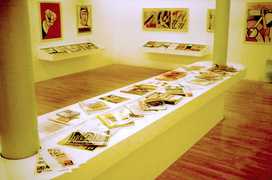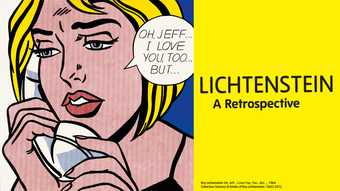
Roy Lichtenstein Installation Shot, Tate Liverpool 1993
Roy Lichtenstein's paintings of comic strip cartoons, washing machines and baked potatoes are 'classics' of Pop Art. But his pictures were seen as brash and banal when they first appeared in the New York art world in the early 1960s. This exhibition surveys three decades of his career from the early Pop paintings to his recent self-parodies.
Roy Lichtenstein was born in New York City 1923. He took a Fine Art degree at Ohio State University and was drafted into the US army in 1943. He brought his first comic strip paintings into the Leo Castelli Gallery in 1961. Castelli saw in them something new and vital and gave him a solo exhibition the following year. The exhibition was an immediate success and stirred fierce controversy in the art world.
Although best known as a painter, Roy Lichtenstein has worked in a variety of media: sculpture, murals, prints and ceramics. This is the first gallery exhibition of his paintings to be held in Britain since that at the Tate Gallery in London in 1968.
'In the early paintings I was looking for a tawdry type of commercialism as found in the Yellow Pages of the telephone directory. They were a great source of inspiration to me.'
On seeing Lichtenstein's paintings, critics complained of the lack of 'artistic' skill. People were offended by his use of commercial subject matter and the apparent crudeness of his painting techniques. For Lichtenstein it was a deliberate ploy to use those things 'that are usable, forceful, and vital about commercial art'.
Lichtenstein restricted his paint colours to imitate the four colours of printers' inks. He also used Ben Day dots, a system devised to increase the tonal range in commercial printing through a dot screen method.
Lichtenstein is famous for his use of strip cartoons from American comic books, which had a wide readership in the 1950s. He admired the skill of the commercial artist who could condense complex stories of love and war into cartoon form.
Lichtenstein was accused of merely copying his sources, but he stressed the changes he made to the composition:
My work is actually different from the comic strips in that every mark is really in a different place, however slight the difference seems to some. The difference is often not great, but it is crucial.


